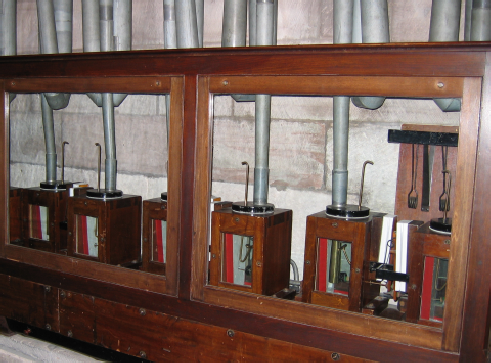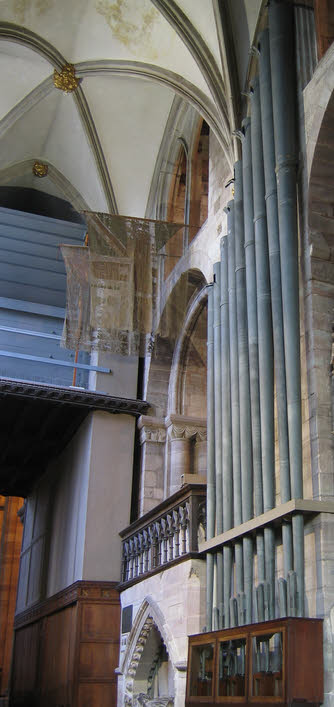

Hauptwerk (v5 and upwards) Virtual Organ
© Lavender Audio 2008 -


It wasn't long before George Robertson Sinclair sought to augment the Hereford tonal scheme and in 1909, Henry Willis II provided a new Ophicleide/Bombarde unit on the Pedal, with wooden resonators. He also installed a Cor Anglais made by French organ builder Rolin Freres and provided 16 foot extensions for the Solo Clarionet, Orchestral Oboe and Tromba. Then, in 1920, the organ was cleaned and the Bombarde 32' wooden resonators were replaced by some made of zinc, which greatly improved the tone.
By 1933, the organ's pneumatic action was starting to wear out and it was becoming obvious that repair was necessary. In addition, tastes in organ design had changed and there was always the danger that the current fashion would dictate some drastic tonal changes as well. Fortunately, the organist, Percy Hull, had no intention of making any changes to sound of the instrument, concentrating instead on the augmentation of the existing sound. The Choir mutations and Trumpet date from this period, as does the Swell Dulzian, which replaced the Vox Humana. Henry Willis III also revoiced and enclosed the Solo flutes and carried out some work on the 32 foot pedal reed. Finally, the five hydraulic blowing engines, which had given service since 1892, were replaced with an electric blower.
This work kept the organ in good order for another 40 years, but by the 1970s, the leatherwork of the instrument that had not been renewed in 1933 was in need of replacement. The console wiring was also becoming a safety hazard and wind leakage had become an increasing problem. The rebuild of 1978 was perhaps the most significant period in the organ's history, coming as it did at the height of the organ reform movement. The influence of Ralph Downes at this time in the UK was considerable and some great Cathedral instruments (notably Gloucester, just down the road) had been changed beyond all recognition. Very fortunately, Hereford had as its organist Dr Roy Massey, whose vision for the Willis was one of conservation – opting to keep true to the great legacy of Father Willis rather than following Continental fashions.
The organ was rebuilt by the country's pre-
All of this work was paid for by local cider makers H.P. Bulmer, whose very generous gift is marked by a tasteful carving on the front of the organ case of the company's logo, a woodpecker.
DEVELOPMENTS AND ADDITIONS FROM 1892 TO THE PRESENT DAY
The final stage of the organ's history is the 2004/5 restoration, which was again carried out by Harrison and Harrison under the direction of current Cathedral organist, Geraint Bowen. The cost of the work was supported by a UK National Lottery grant of £269,500 and consisted largely of restoration and repair, with the only tonal change being the revoicing of the Pedal Schalmei so that the rank has now become a Clarion. Given that this latest work took place in a period where conservation of historic material is paramount and unsuitable additions are generally dispensed with, the fact that only one tonal change was considered necessary is testament to the careful stewardship the organ has enjoyed over the years.
For further detail on the organ's history, see Roy Massey's excellent chapter in the book “Hereford Cathedral”, ISBN 1852851945, published by Hambledon.
The bottom octave of the Bombarde 32’ with a close-







